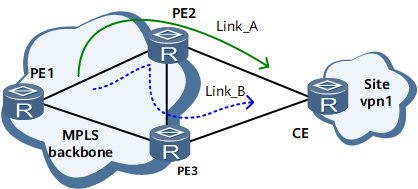Configuring IP+VPNv4 Hybrid FRR
This section describes how to configure IP+VPNv4 hybrid FRR. On a network where a CE is dual-homed to two PEs, if the link between the master PE and the CE is unreachable, the master PE switches traffic to the link between the backup PE and the CE for transmission. IP+VPNv4 hybrid FRR improves network reliability.
Usage Scenario
IP+VPNv4 hybrid FRR can quickly switch traffic from a PE to another PE that serves as the backup next hop if the primary route to a CE is unreachable.
A PE learns VPN routes with the same prefix from a CE and other PEs. In this situation, IP+VPNv4 hybrid FRR can be configured on the PE. After being enabled with IP+VPNv4 hybrid FRR, the PE generates a primary route and a backup route to the VPN prefix. If the link between the PE and CE fails, the traffic quickly switches to the backup next hop (backup PE).
On the network shown in Figure 1, in normal situations, PE1 selects Link_A to forward traffic to the CE and uses Link_B as the backup link. If PE2 detects that the route to the CE is unreachable, it will immediately switch traffic to Link_B and private network routes will be converged. This implementation minimizes the impact on VPN services.
At present, the NetEngine 8000 F supports the following IP+VPNv4 hybrid FRR modes:
Private network IP FRR: applies to the networking where a non-BGP routing protocol runs between the PEs and CE.
Private network BGP auto FRR: applies to the networking where BGP runs between the PEs and CE.
